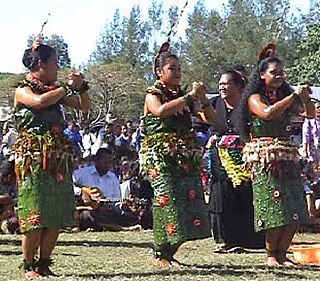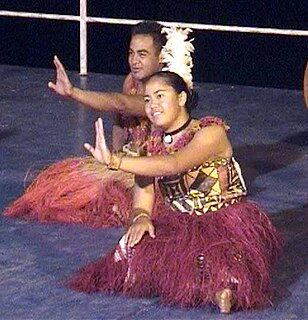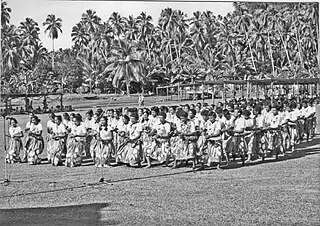The maulu'ulu was originally an artistic expression of everyday activities, domestic duties, and customary observations. Such themes are readily observed in the motifs embedded within lyrics and choreographies which allude to tasks such as weaving, paddling, making tapa cloth, cultivating crops, and fishing. While these themes are common in other Samoan dance and song genres, the ma'ulu'ulu is distinguished by the staggered rows of performers executing the same movements. Performers in the front rows usually sit cross-legged, while middle rows kneel, and back rows stand. Another distinguishing feature of the Samoan ma'ulu'ulu is the coordinated transitioning between seated, kneeling, and standing positions.
The word maulu'ulu' literally means "to sprinkle" or "light rain" - alluding to the lighthearted and jovial style of performance which was intended to refresh and reinvigorate audiences and social events as a "light rain" would cool the stifling tropical heat of a summer day.
Formations and transitions are the hallmark of the maulu'ulu - the graceful footwork employed in walking from one row to another or from one area of performance to another. Mirrored motifs are commonly choreographed in such a way that the movements of one row of dancers is mirrored by corresponding movements executed by the dancers in the adjacent row. Proficient dancers are judged by the expressions of the face (smiling) and head, along with the grace and animation of hand and finger movements and smooth transitioning footwork.
The seated and kneeling formations of the Samoan maulu'ulu are the most visible component of the Tongan Ma'ulu'ulu analog genre of Tonga. The Tongan ma'ulu'ulu in its current stylistic performance is more akin to the Samoan Sasa.
The Manu Samoa rugby team used to perform a lively version of the ma'ulu'ulu as a pre-game warm-up ritual until 1991 when the siva tau was choreographed (based on the Maori haka made famous by the New Zealand All Blacks rugby squad.
The kailao is a cultural dance from the South Pacific country of Tonga. It originates from Wallis and Futuna.

The Tonga national rugby union team represents Tonga in men's international rugby union. The team is nicknamed ʻIkale Tahi . Like their Polynesian neighbours, the Tongans start their matches with a war dance – the Sipi Tau. They are members of the Pacific Islands Rugby Alliance (PIRA) along with Fiji and Samoa. The Ikale Tahi achieved a historic 19–14 victory over France in the 2011 Rugby World Cup, but having lost to New Zealand and Canada, were unable to achieve what would have been their first-ever presence at the quarter-finals.

Samoans or Samoan people are the indigenous Polynesian people of the Samoan Islands, an archipelago in Polynesia, who speak the Samoan language. The group's home islands are politically and geographically divided between the Independent State of Samoa and American Samoa, an unincorporated territory of the United States of America. Though divided by national border, the culture and language are the same.
Polynesian culture is the culture of the indigenous peoples of Polynesia who share common traits in language, customs and society. The development of Polynesian culture is typically divided into four different historical eras:

Yvonne Rainer is an American dancer, choreographer, and filmmaker, whose work in these disciplines is regarded as challenging and experimental. Her work is sometimes classified as minimalist art. Rainer currently lives and works in New York.

The Tonga national rugby league team represents Tonga in rugby league football. They are currently the third ranked team in the world. The team was formed to compete in the 1986 Pacific Cup, and have competed at five Rugby League World Cups, starting in 1995 and continuing consecutively until the most recent tournament in 2017, where they achieved their best ever result as semi-finalists.

The tauʻolunga is a traditional Tongan dance. It is a combination of the Samoan Taualuga and the Tongan ula. The type of dance is comparable with (some) Hawaiʻian hula or the Tahitian ʻaparima.
The ula (dance) is an ancient Tongan group dance, already reported by early European navigators like captain Cook. It is also known as fahaʻi-ula, which may be degenerated to fahaʻiula. Traditionally it is performed after an ʻotuhaka. It is still danced nowadays, although less popular than its descendant the tauʻolunga.

The ʻotuhaka is a traditional Tongan group dance with prominent Sāmoan influence wherein the performers are seated and make gestures with their arms only, with some accentuation from head and body.
The māʻuluʻulu is a traditional Tongan dance, performed by a group of seated men and women; stylistically, the dance form is a direct successor of the ancient Tongan ʻotuhaka having been synthesized with the Samoan Māuluulu which was imported during the 19th century.

Sōkē or eke is a Tongan group dance performed with sticks which the performers hit against each other on the beat of the drum. It has some common elements with, but is a complete independent development from the English Morris dance. As with most Tongan dances, the whole performance is to dazzle the spectators and to please the chiefs. There is no hidden purpose.

The fire knife is a traditional Samoan cultural implement that is used in ceremonial dances. It was originally composed of a machete wrapped in towels on both ends with a portion of the blade exposed in the middle. Tribal performers of fire knife dancing dance while twirling the knife and doing other acrobatic stunts. The towels are set afire during the dances, hence the name.

The tautoga is considered the most formal and restrained style of Rotuman dance, usually seen performed in large festivities or ceremonies, or in public opportunities to showcase Rotuman culture. The tautoga style can be seen as comparable to the Tuvaluan fatele or Tongan lakalaka, and the "toga" [ˈtoŋa] sound to the word alludes to such an origin.
This is a history of the Tonga national rugby league team.

Rugby union is the national sport in Tonga. Sumo has a following, while football, judo, surfing, volleyball, and cricket have gained popularity in recent years. Rugby league and Australian football are also played.
Lucinda Childs is an American postmodern dancer/choreographer and actress. Her compositions are known for their minimalistic movements yet complex transitions. Childs is most famous for being able to turn the slightest movements into intricate choreography. Her use of patterns, repetition, and dialect has caused her to have a unique style of choreography that is often imitated for its ability to experiment.
Sean-nós dance is an older style of traditional solo Irish dance. It is a casual dance form, as opposed to the more formal and competition-oriented form of Irish stepdance.
In Australia, calisthenics is a team-based competitive performing art taking elements of rhythmic gymnastics and ballet combined with a strong emphasis on theatricality, costume, dance and musical interpretation. Since the 1950s Calisthenics has been an entirely female art form, however males have recently been re-introduced in the younger age groups. The art form was created entirely in Australia and can be easily differentiated from traditional calisthenics by its focus on competition and choreographed theatrical performance instead of simple synchronized exercise. The word itself comes from the Greek words for beauty and strength. Calisthenics is currently practiced in all states except Tasmania.
The Taualuga is a traditional Samoan dance, considered the apex of Samoan performance art forms and the centerpiece of the Culture of Samoa. This dance form has been adopted and adapted throughout western Polynesia, most notably in Samoa, The Kingdom of Tonga, Uvea, Futuna, and Tokelau. The renowned Tongan version is called the tau'olunga.
In dance, floorwork refers to movements performed on the floor. Floorwork is used extensively in modern dance, particularly Graham technique and Hawkins technique, as well as in vernacular breakdancing. Some dance training practices, notably Floor-Barre, consist entirely of floorwork.









